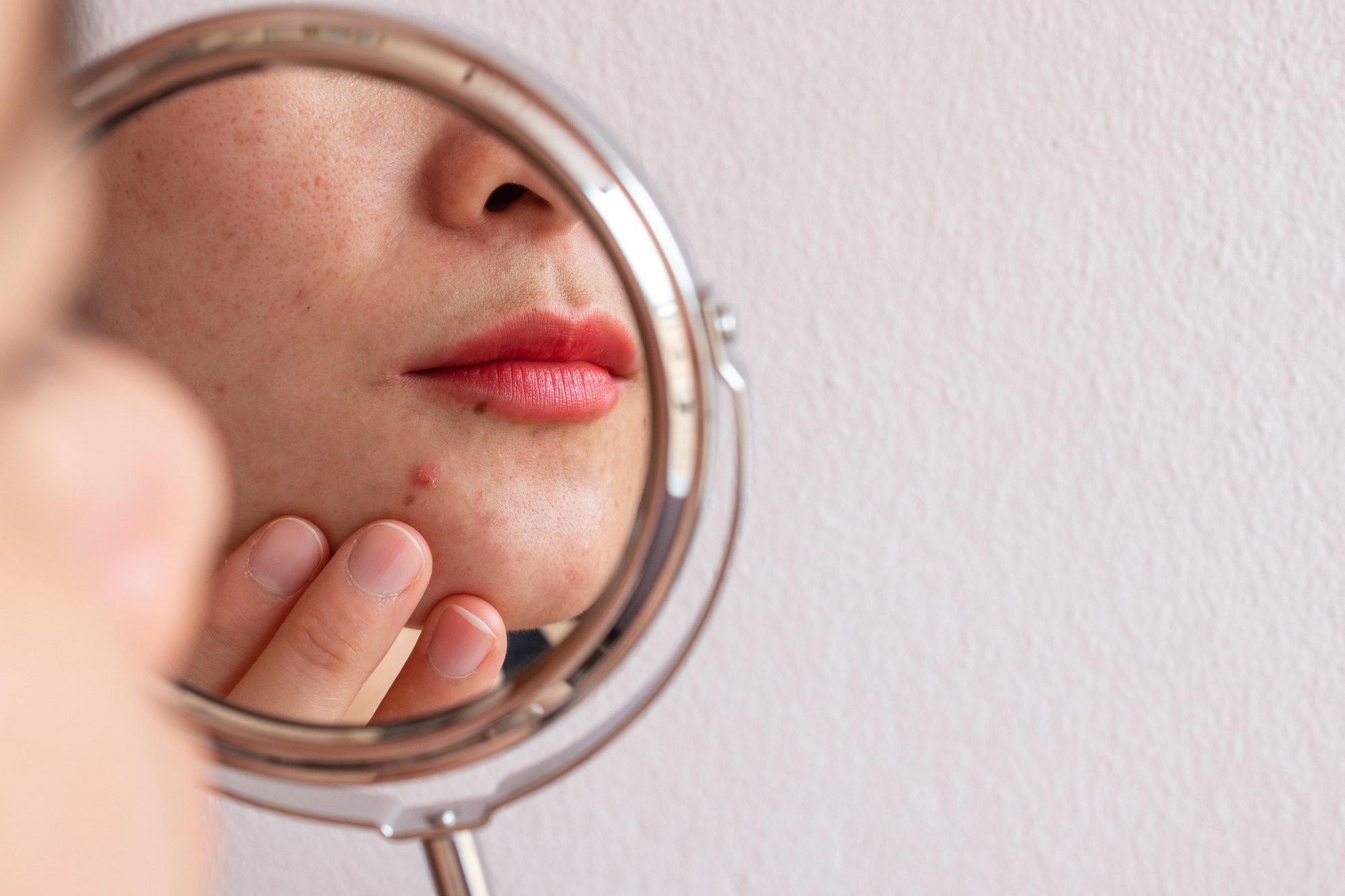In a recent study published in Nutrients, researchers evaluated the associations between diet, rosacea, and acne.
Study: Dietary Patterns in Acne and Rosacea Patients—A Controlled Study and Comprehensive Analysis. Image Credit: Boyloso/Shutterstock.com
Background
Rosacea and acne vulgaris are common skin conditions that require appropriate foods to complement treatment regimens. Assessing the influence of diet on facial dermatoses is challenging due to subjective self-reported information, lack of contemporary diet patterns, and the absence of disease-specific dietary protocols.
Extensive observational-type controlled trials are required to determine relationships between particular food items and disease risks and develop preventive interventions and therapeutics.
Information on the dietary modification of rosacea is limited compared to acne, with scarce diet guidelines.
About the study
In the present cross-sectional, controlled study, researchers investigated the eating patterns of rosacea and acne patients.
The exploratory study was carried out from September 2020 to June 2021, including the following groups: the rosacea patient group (RG) and the acne patient group (AG), with their corresponding control groups, RCG and ACG, respectively.
All individuals were aged ≥12 years and included irrespective of disease severity and therapy. The control groups comprised healthy individuals without prior facial dermatosis history and were matched for age, body mass index (BMI), and sex.
Pregnant and lactating women were excluded from the analysis. Dietary patterns of the individuals in the previous four weeks were assessed subjectively by self-documentation of beneficial and trigger foods, followed by standard food frequency surveys (FFS) for dietary habits.
The team developed the rosacea nutrition score (RNS) and the acne nutrition score (ANS) based on eating habits to predict the risks of rosacea and acne and the Receiver Operating Characteristic (ROC) values for the food items.
The predictive ability and accuracy of the scores were evaluated using the area under the ROC curve (AUC) findings, and only those with AUC values exceeding 0.6 contributed to the scores.
Further, the team used the Youden Index for cut-off determination, the Dermatology Life Quality Index (DLQI) to evaluate the dietary influence on life quality, and the EuroQol EQ-5D-EL scores to assess the health status.
The predilection locations for acne (chest, back, and face) and rosacea (eyes, chest, and face) were inspected, and disease severity was graded by a dermatologist based on inflammatory lesions (pustules, papules) and non-inflammatory lesions (comedones) for acne.
In addition, the three main types of acne, i.e., acne comedogenic, conglobate, and papulopustolosa, were identified. The team used the global ROSacea COnsensus (ROSCO) criteria for rosacea patients. The participants also self-reported disease severity as mild, intermediate, and severe.
Facial sebum expression, skinfold thickness, and fat at the biceps, triceps, supra-iliac, and subscapular regions were assessed.
Serum samples were obtained to measure glucose, IGF-1, insulin, glycated hemoglobin (HbA1c), cholesterol, fructosamine, triglycerides (TG), Homeostatic Model Assessment for Insulin Resistance (HOMA) index, C-reactive protein (CRP), total white blood cell count, zinc, and vitamin D levels.
Results
In total, 296 individuals were included, of whom 120, 32, 105, and 36 belonged to the AG, ACG, RG, and RCG groups, respectively. Acne and rosacea patients expressed sebum in significantly higher levels on their faces than their corresponding controls.
The FFS findings indicated that 81% of acne patients and 71% of rosea patients reported that diet impacted disease severity.
Dietary triggers for acne include fried foods, chocolate, milk, refined sugar, dairy products, and alcohol. Rosacea patients reported alcohol, particularly wine, as the primary trigger, followed by fried foods, spices, coffee, chocolate, milk, and refined sugar.
Acne and rosacea patients perceived nuts, vegetables, fish, tea, and whole grains as beneficial for skin health. Fruits, specifically citrus fruits, seemed to benefit acne patients but triggered rosacea.
Individuals with acne ate significantly fewer vegetables, fruits, pasta, soy products, and boiled potatoes than their controls. In addition, they consumed coffee, water, milk, and wine in low quantities.
RG patients ate more ham, honey, meat, fried potatoes, and burgers than their controls. In contrast, individuals with rosacea consumed significantly fewer legumes and soy and consumed coffee significantly less than controls.
Of note, rosacea patients consumed significantly more oral supplements than acne patients. The clinical scores were more precise for acne than rosacea, with ORs of 14.5 and 5.5, respectively. Cut-offs of 7.0 and 4.0 were determined for the 13-item ANS and seven-item RNS, respectively.
The AG group showed significantly higher insulin-like growth factor (IGF)-1 and lower TG levels than controls.
Individuals with increased IGF-1 expression showed an increased likelihood of chest acne (62%) than face acne (34%) and consumed significantly more dairy foods than those with unaltered IGF-1 expression.
Acne conglobata had higher HbA1c and CRP levels than acne comedonica and papulopustulosa. Individuals with rosacea showed significantly increased HOMA scores and reduced zinc and TG levels compared to their controls.
Compared to rosacea patients, acne patients had significantly higher levels of IGF-1, cholesterol, low-density lipoprotein (LDL), and TG. Acne more profoundly impacted life quality than rosacea, with mean scores of 7.0 and 5.4 on the DLQI scale, respectively.
Conclusion
Overall, the study findings highlighted the dietary regulation of rosacea and acne. Consuming legumes, vegetables, nuts, olive oil, and oily fish while limiting cheese, alcohol, and meat could benefit rosacea and acne patients.
The findings could aid in developing tailored interventions for improved outcomes, and healthcare professionals could utilize the clinical scores for risk stratification by dietary habits.
Credit: Source link




